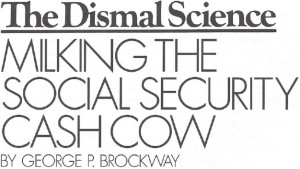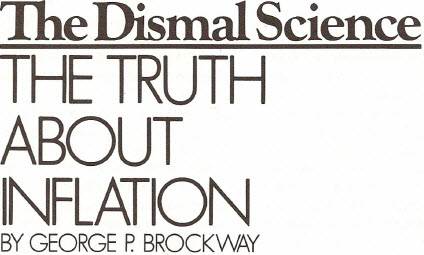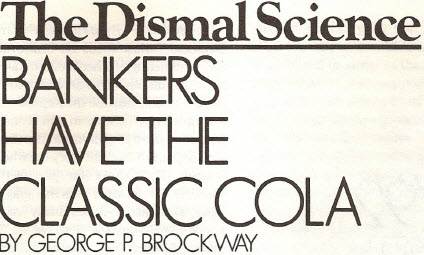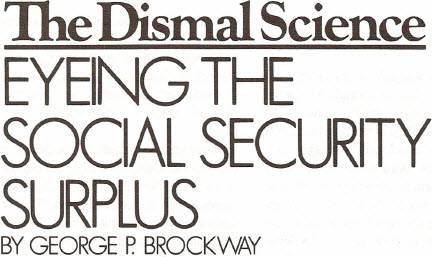By George P. Brockway, originally published August 9, 1999
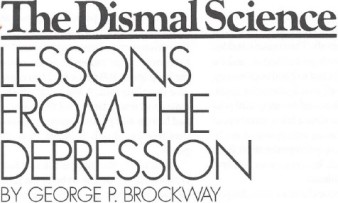 THE NEW Congressional committee created ostensibly to reach a nonpartisan solution to the Social Security “crisis” may not really be intended to do anything, except perhaps issue a report calling for further study of the problem. In fact, I think it is probably a device for changing the subject whenever some humorless member of Congress tries to make an “issue” out of Social Security. “We must wait until the committee reports,” will be the ready response. If I’m right, Social Security will be effectively eliminated from the front lines of the November general election campaign, and no one will have to take a possibly unpopular stand either for or against any of the myriad “reform” schemes lurking on the horizon.
THE NEW Congressional committee created ostensibly to reach a nonpartisan solution to the Social Security “crisis” may not really be intended to do anything, except perhaps issue a report calling for further study of the problem. In fact, I think it is probably a device for changing the subject whenever some humorless member of Congress tries to make an “issue” out of Social Security. “We must wait until the committee reports,” will be the ready response. If I’m right, Social Security will be effectively eliminated from the front lines of the November general election campaign, and no one will have to take a possibly unpopular stand either for or against any of the myriad “reform” schemes lurking on the horizon.
My junior high school civics teacher would be saddened to hear of my lapse from her innocent teaching, but I, for one, am enthusiastically in favor of another do-nothing committee on Social Security. A little over a year ago the much larger National Commission on Retirement Policy, made up of presumed experts business leaders, academics, Congressmen- managed to split three ways on which reform should be endorsed; so nothing was done. That was fine, because all of them would have gotten Social Security mixed up with the stock market in one way or another. Since the stock market is still dangerous, our need for a do-nothing committee is still great.
Nevertheless, I have not forgotten all I learned in those dear, departed civics classes, where we were taught to analyze legislation under three headings: (1) the need for the law, (2) the constitutionality of the law, and (3) the proper taxation to pay for it. That continues to strike me as a good, systematic approach, and I hereby suggest that the committee spend its time looking at the existing Social Security Act accordingly. This will give it something to do that no prior committee has done and keep the matter bottled up until after the balloting. Let me demonstrate.
1. Why was the Social Security Act needed? Well, there was a jim-dandy depression on. There being no official or semi-official definition of “depression,” one has to be supplied: A depression is a massive, comprehensive and persisting breakdown of the economic system. The economy does not recover without major changes or a major shock or both.
In the 1930s, millions and millions of people were out of work; the municipal poorhouses and charity soup kitchens were overwhelmed; beggars were everywhere; bands of hobos hitched long journeys on freight trains, tracking the seasons or wandering aimlessly. In most towns, near the freight yards or in the gashouse district, there appeared “Hoovervilles” of shacks made from old cartons and discarded (or stolen) boards, furnished with broken furniture from the town dump. In many cities a portion of the local jail was used as a temporary shelter for the more respectable homeless. I myself spent a night as a guest of the Hudson, New York, jail in the course of a hitchhiking journey to search for a job that I didn’t find.
The Great Depression was not a pretty time. Millions suffered, despite having worked long and hard and faithfully. Their dependents, of course, suffered along with them. So did young people coming fresh to a labor market that had no place for them. The society had failed, not a particular individual or group or class. Thus the Social Security Act was needed to deal with at least one aspect of the collapse of the social system-namely its effects on the elderly, the disabled and the orphaned.
2. Was the act constitutional? That proved to be a tough question for a Congress dominated by Southern Dixiecrats and Northern Republicans, and for a Supreme Court possessed of states’ rights notions that had become obsolete at Appomattox Court House on April 9, 1865. It took six years of depression for Congress and the Supreme Court to follow the election returns and take the general welfare seriously. Follow they eventually did, and our second question was answered in the affirmative.
3. Is the taxation appropriate? That question is still with us. The dispute today concerns the adequacy of the present payroll tax. No one wants to increase the rate. Some want to increase the income by putting a portion of the money in the stock market; others argue that income will be more than sufficient as long as the economy remains robust. The real trouble, however, is in the method of taxation itself.
A payroll tax has nothing going for it. It is comparatively easy to evade, especially by those in domestic or casual work. It also discourages employment. If you have a job, that laudable fact triggers a tax on you or your employer or both. On the other hand, if you are a professional gambler, or if all you do for a living is clip coupons and play the market, you don’t pay any payroll tax.
To be sure, aid for the needy is a responsibility of the state; and all businesses-manufacturing, wholesale or retail –owe their existence to the state. In some cases the state licenses or charters or franchises them; and in every case the state protects the society that is the source both of their work force and their market. Consequently, it is reasonable for businesses to be taxed to help pay for the general welfare of the government that nourishes them.
But a payroll tax is a poor way to do it. It is an up-front cost that must be met with the first employee hired, that increases with each additional employee and each wage increase given, and that continues until the last hour of the last employee’s employment. In his book The Next Left, the late Michael Harrington argued that French President Francois Mitterrand‘s bold, popular and promising social policies resulted in economic stagnation because he financed them by levying payroll tax after payroll tax. Instead of expanding, French industries cut employment to the bone in a largely vain attempt to keep their prices competitive with those of neighboring countries. The failure of Mitterrand’s programs had nothing to do with the fact that he was a Socialist. Their effect would have been the same even if the programs had been private fringe benefits.
OUR Social Security system, although in many respects the most successful legacy of the New Deal, has twice the vices of an ordinary payroll tax, since both employee and employer are taxed. Wage negotiations are rendered more difficult because the employees’ present value of any wage is reduced by the 6.2 per cent Social Security tax plus the 1.45 per cent Medicare tax, while for employers labor costs are increased by the same 7.65 per cent (called, no doubt to spare their delicate sensibilities, a “contribution”).
In addition, the Social Security tax has the extraordinary effect of being a radically regressive tax on the nation’s workers, especially the working poor. It is, to begin with, a flat tax–even flatter (as far as it goes) than the various flat tax proposals of current Republican politicians. It has no exemptions or credits, and starts with the first penny a worker earns. It continues at 7.65 per cent on both employee and employer until the employee earns $72,600, whereupon only the Medicare portion remains. A Fortune 500 CEO who pulls down $10 million a year therefore pays a rate that is less than one ten-thousandth of the rate paid by the charwoman whose job it is to clean up after him.
Nor are these the only indefensible unfairnesses of the Social Security tax. More important in the long run is the fact that the tax has been used to eliminate the higher brackets of the personal and corporate income taxes, and hence exacerbates the widening gap between the rich and the poor in the United States.
The Social Security system is said to be a pay-as-you-go plan, but of course it isn’t. It is a pay-years-before you go plan. The Trust Fund that is being paid for now will not be used up before 2029, and probably much later, if ever. In next year’s budget, the total of employee taxes, employer contributions, and interest earned by the Trust Fund is $636.5 billion, while the entire cost of Social Security (beneficiaries, bureaucrats and all) is only $408.6 billion. The $227.9 billion Social Security surplus not only goes to make possible the budget balance everyone is so proud of, but also accounts for the entire budget surplus that Congress is squabbling about.
The trouble with Social Security; in short, is the method of meeting the costs. A payroll tax is adverse to national employment and investment, and is unreasonable in its incidence. Moreover, the present payroll tax may be incapable of paying the bills. It is anticipation of the last that has caused today’s uproar. But speculating on the stock exchange, whatever else may be said for or against it, is almost guaranteed to fail at the most critical moment. A booming stock market does not guarantee a booming economy, but a crashing market is sure to bring the economy down with it.
Again I can offer a personal reminiscence. My father put together a satisfactory nest egg by playing the boom market of the 1920s. When the ’30s began he believed President Herbert Hoover and did not “sell America short.” In August 1933 he died broke. As the HMO lobby’s ads say, “There must be a better way.” And there is: The Social Security Act addresses a national need and it should be funded by a national tax. The income tax does not inhibit employment and investment, because it falls only on persons and enterprises capable of sustaining employment and investment.
It is often argued that the income tax is too subject to the cold and shifting winds of politics to be the support for something as vital as Social Security. But the raucous history of the present debate has surely demonstrated that Social Security is in any event buffeted by the very same winds as the rest of our political life.
The New Leader
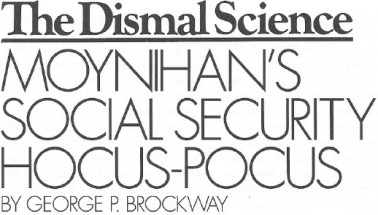 ON MARCH 16
ON MARCH 16 